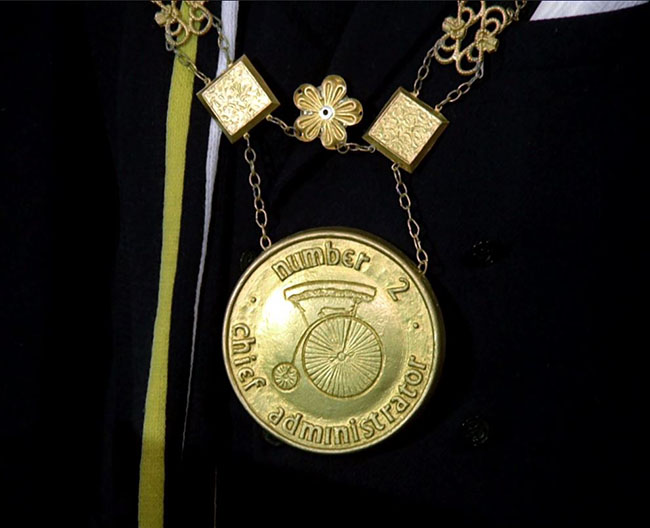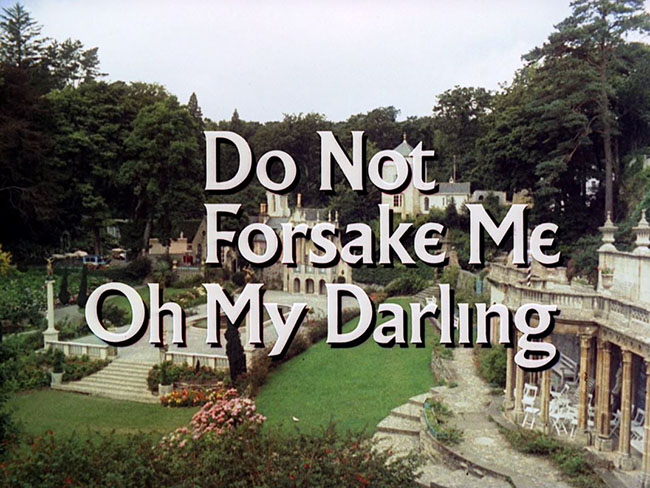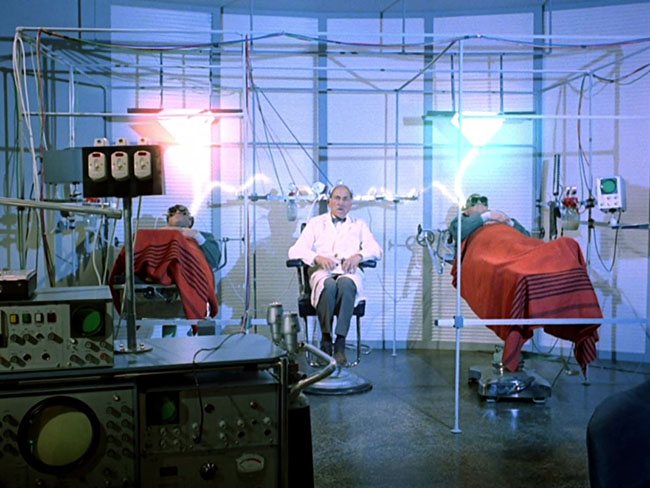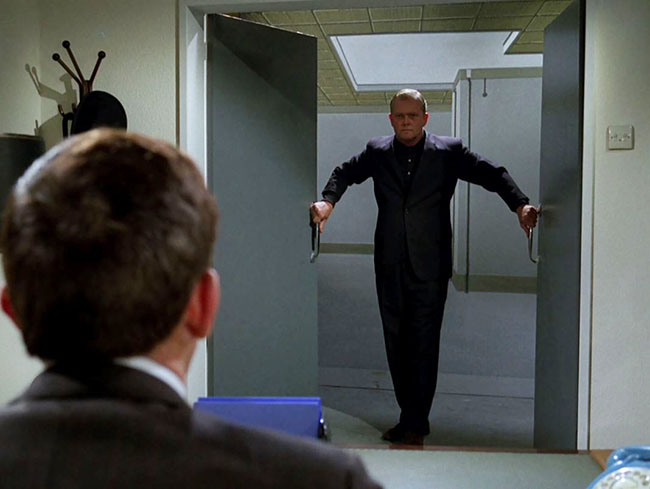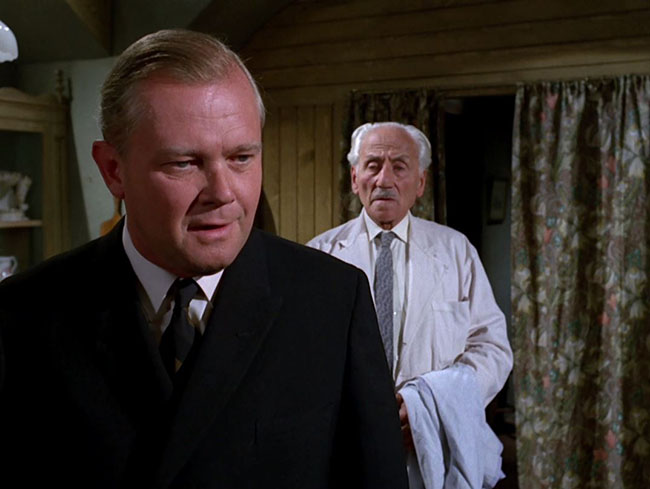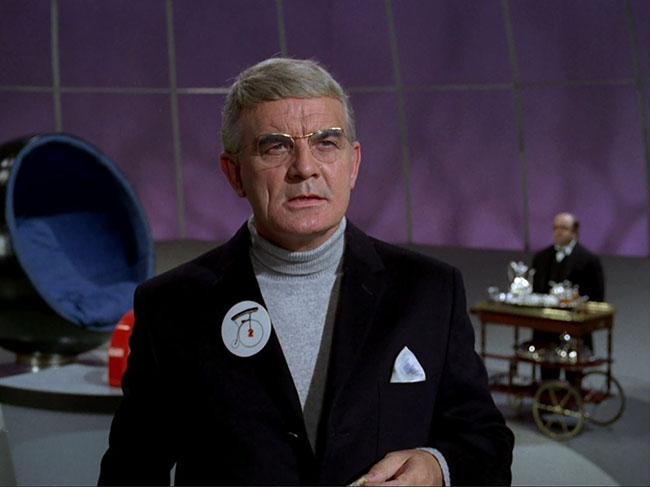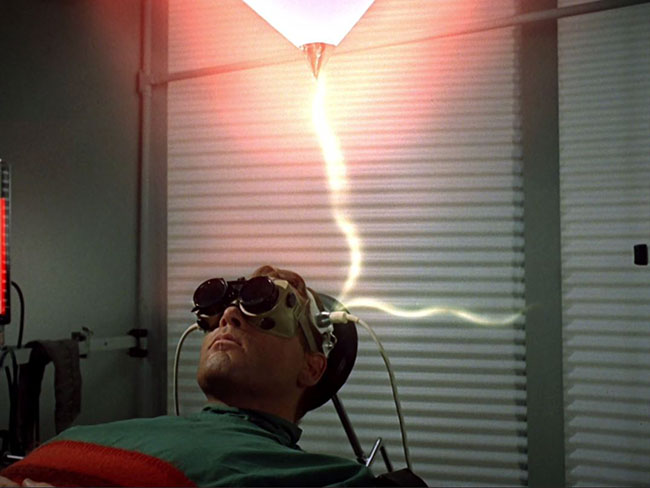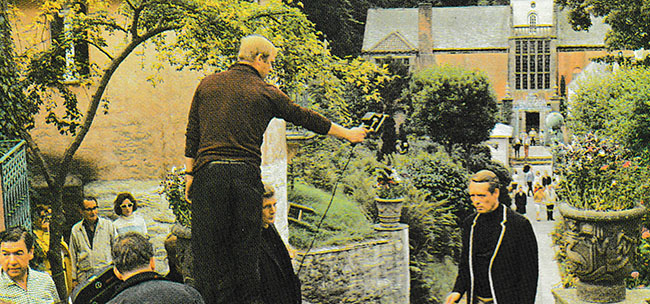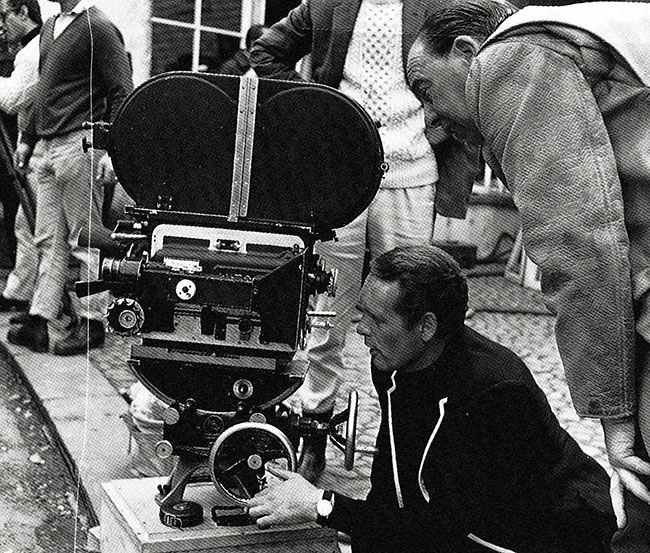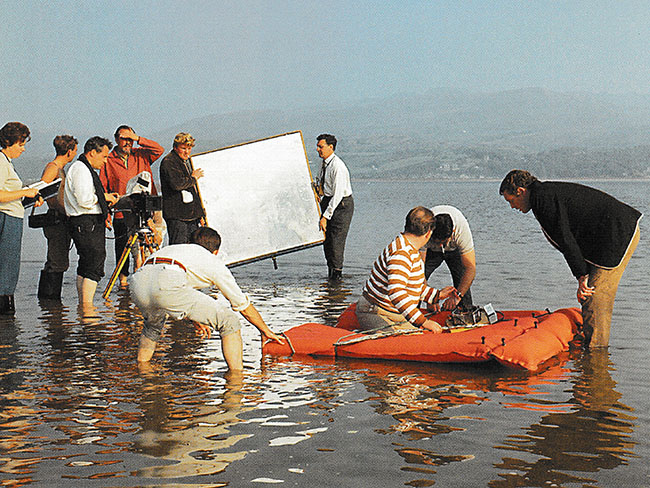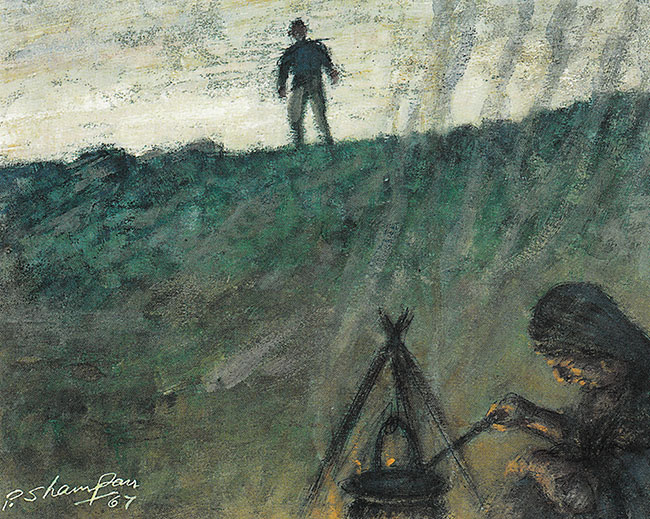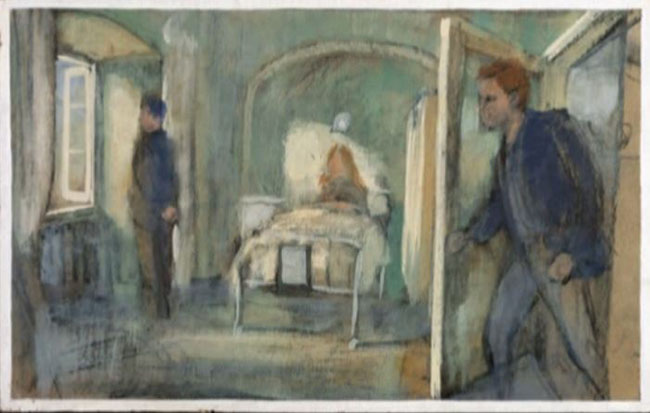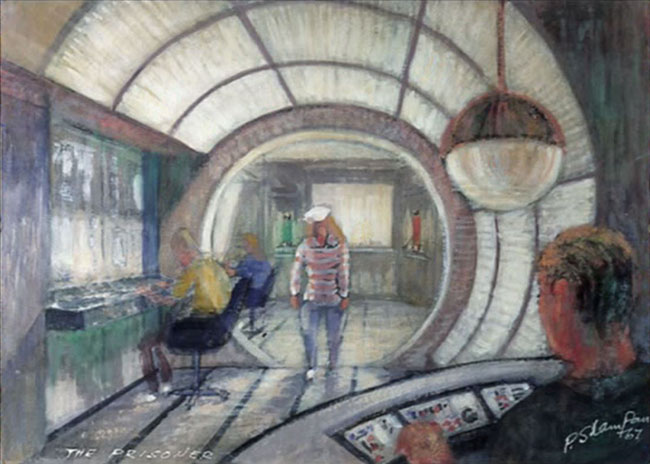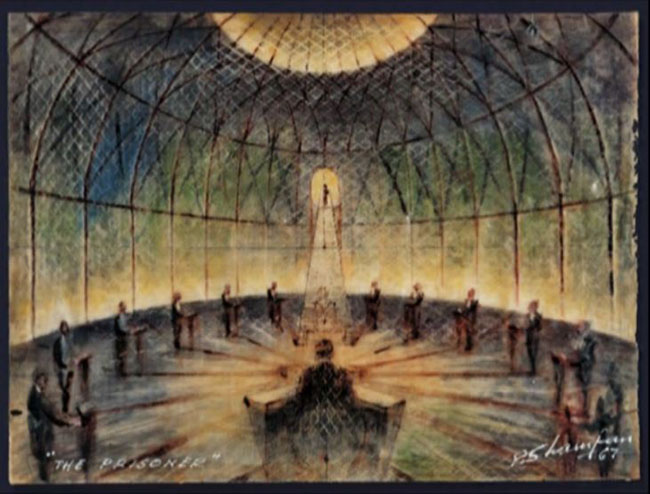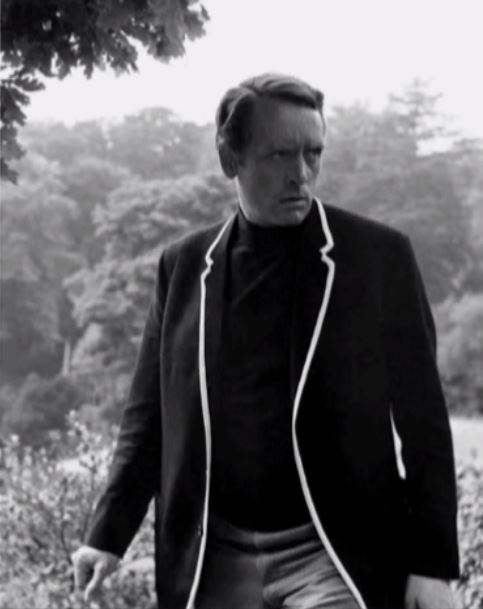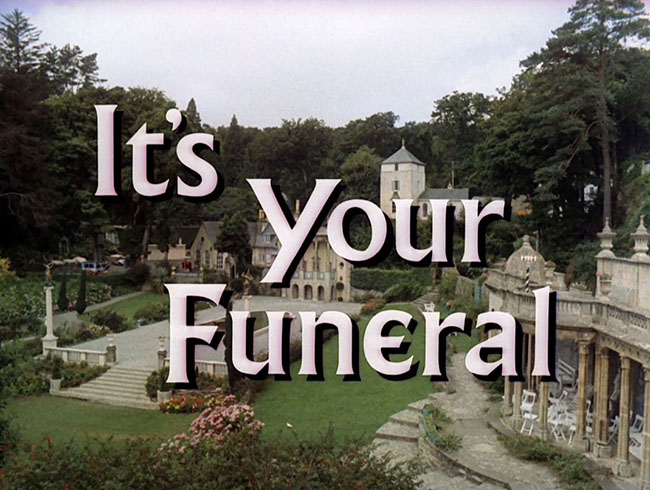
IT’S YOUR FUNERAL First UK Broadcast: December 8, 1967 [episode #11 in transmission order] | Written by Michael Cramoy | Directed by Robert Asher
SYNOPSIS
One morning the local Watchmaker’s daughter, No.50 (Annette Andre), shows up at No.6’s door asking for his help in foiling an assassination plot. If it succeeds, she says, there will only be brutal recrimination against all Villagers. She doesn’t believe the assassination plot will be taken seriously due to the number of false plots, or “jamming,” created by those in the Village who wish to confuse their observers. No.6 is suspicious of her and turns her away. Indeed, we see that they are being watched on one of the Supervisor’s cameras by the New No.2 (Derren Nesbitt), who’s masterminded this meeting between No.50 and No.6 without the woman’s knowledge. His purpose at this point is unclear, but we can see he is reporting back to his superiors, perhaps No.1. While No.6 plays a game of “kosho,” a competitive sport, No.100 (Mark Eden), working for No.2, opens No.6’s locker and replaces his watch with a broken one. No.6 goes to visit the Watchmaker (Martin Miller) to have it repaired, and notices that the man is constructing the trigger mechanism for a bomb. He learns the target is No.2, and goes to warn him – but there is someone different occupying the globe chair (Andre Van Gyseghem). This No.2 is actually the old one – he will be retiring and leaving the Village, and Nesbitt’s No.2 was holding his office while he was away, soon to replace him after a ceremony. The outgoing No.2 (as I’ll refer to him) has been given a recording showing No.6 warning previous holders of his office of a nonexistent plot, and he writes him off as paranoid. No.6 realizes that the incoming No.2 created the footage and is behind the assassination plot. On Appreciation Day, the outgoing No.2 is to be presented with a medallion, the Great Seal of Office, and inside it is hidden the bomb which will be remotely triggered by the Watchmaker. No.6 successfully prevents the trigger from being activated by confronting the Watchmaker and No.100; and the outgoing No.2 presents the medal-bomb to the incoming one, much to the man’s terror. No.6 hands the outgoing No.2 the trigger device, which purchases the gentleman’s safe passage by helicopter out of the Village. No.6 warns the new No.2 that he may one day be treated by his superiors the same way when he tries to retire.
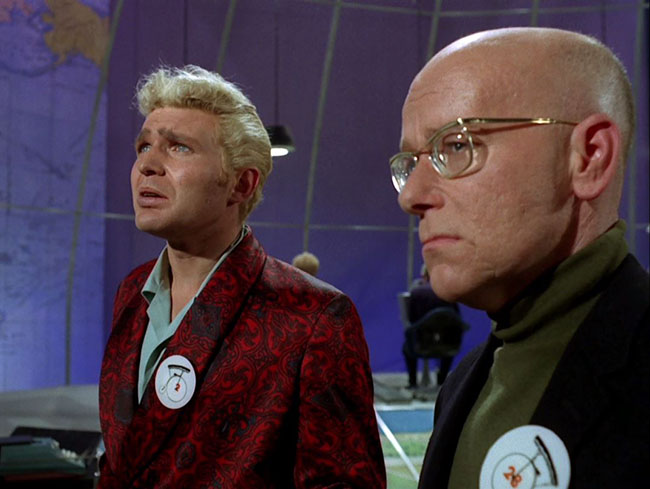
The new No.2 (Derren Nesbitt) explains his plan to the Supervisor (Peter Swanwick).
OBSERVATIONS
This is a very convoluted episode, though I had a somewhat easier time following it this round than the countless times I’ve watched it before. To keep this straight: the new No.2 (Nesbitt) is acting under the command of someone else (No.1?) to assassinate the outgoing No.2 (Van Gyseghem), possibly to justify taking greater authoritarian measures against the Villagers. Because everyone under the Village is under 24/7 surveillance, he knows the plot will be uncovered, and so he hopes to undermine it by first allowing No.6 to discover the plan and then to discredit him, essentially making him out to be one of the “jammers” who create false plots to gum up the works. Nesbitt has expressed that he was completely confused during the entire filming and couldn’t get a straight answer out of McGoohan, either. The script is the only Prisoner by Michael Cramoy, writer of episodes of The Saint, Dragnet, and Ralph Smart’s Invisible Man. If nothing else, it proves that the format of the show could accommodate the paranoid government conspiracy thriller, a genre that would become more popular in a few more years (though The Manchurian Candidate is an apparent touchstone here). It may just be post-production tinkering or maybe even on-the-set rewrites, but it’s very hard to follow each revelation. For example, No.6 is introduced to the outgoing No.2 after he meets the new No.2, and so to him – and the viewer – it appears that the man he’s just met has replaced Nesbitt’s character. For clarity it would have been helpful to establish the retiring No.2 and the concept of the hand-off ceremony on “Appreciation Day” at the start of the episode, so we can benefit from a basic understanding of the stakes and suspense can build. The viewer can’t be expected to know that there can be two people acting as No.2 at the same time, since this information contradicts “Arrival.”
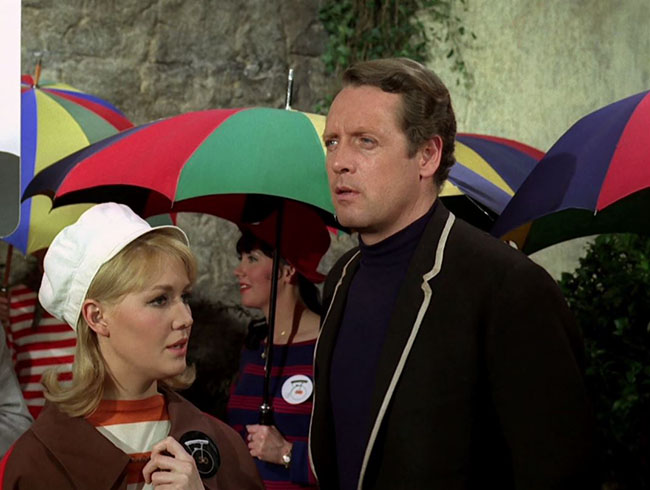
No.6 and the Watchmaker’s Daughter (Annette Andre) try to foil an assassination plot on Appreciation Day.
It was a stressful shoot, with McGoohan abruptly firing director Robert Asher and taking over directing duties himself. Annette Andre didn’t get along with McGoohan, and neither did Nesbitt. Mark Eden claimed that McGoohan lost control during their fight scene together. With the strain of the production taking its toll on McGoohan and the crew – and George Markstein on the verge of quitting – it was becoming clear the show couldn’t go on indefinitely; the end of The Prisoner was on the horizon. But don’t get me wrong. This is a very watchable episode, and leagues better than, say, “Do Not Forsake Me Oh My Darling.” Refreshing for a later episode, it includes Portmeirion location shooting. The climax, with Nesbitt being forced to drape the bomb around his own neck, is amusing and satisfying. On my trip to Portmeirion in the mid-90’s, the clerk at the Prisoner Shop was trying to explain their replica of the Great Seal of Office to a baffled customer who clearly only had a passing familiarity with The Prisoner. “And the great thing is,” the clerk said with great enthusiasm, “the bomb never goes off! They’re carrying around a bomb and we never even get to see it go off!” I am sad to report the customer did not purchase the seal of No.2.
SEQUENCE
We know that No.6 has been in the Village for a while, since he tells No.50 that he’s been burned many times before. His suspicion of her is downright hostile.
I am placing “It’s Your Funeral” here because it provides some Village scenery in between two episodes that take place elsewhere. It also introduces No.6’s outdoor workout space and kosho, both of which will reappear later. To recap our episode order so far:
#1 Arrival
#2 Free for All
#3 Checkmate
#4 Dance of the Dead
#5 The Chimes of Big Ben
#6 The Schizoid Man
#7 Many Happy Returns
#8 The General
#9 A. B. and C.
#10 Do Not Forsake Me Oh My Darling
#11 It’s Your Funeral
Six more to go!
6 OF 1…
We get an overview of how No.6 bides his time in the village. He’s built a makeshift workout facility in the middle of the forest where he exercises. He waterskis and plays kosho. At the Old People’s Home, he plays chess and poses for a portrait, which turns out to be an abstract one.
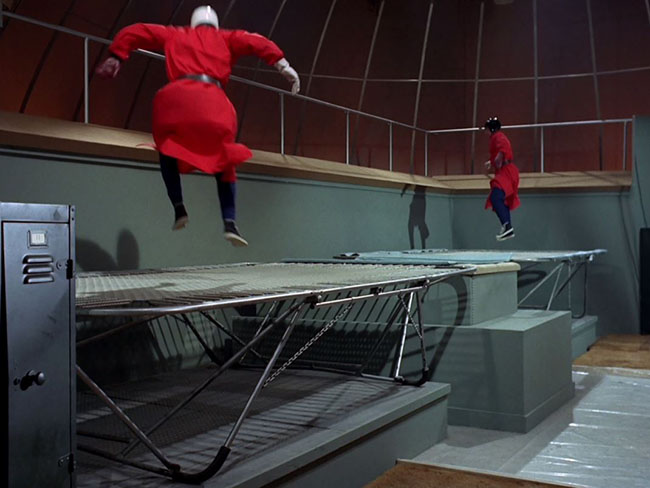
The game of kosho.
KOSHO
McGoohan invented this game for The Prisoner and was dressed in his kosho uniform during the show’s unique 1967 press conference, which took place amidst props from “Once Upon a Time.” Though the rules are never explicitly stated, we can get a pretty good idea of how kosho is played. The two athletes bounce on opposite trampolines, a tank of water between them. The goal is to dunk your opponent into the water. The uniform consists of a red belted robe, a white helmet, and a single padded glove. You can strike your opponent as you bounce back and forth, trading places or running along either the neighboring wall or the edge of the tank. The name of the sport has Japanese connotations. It’s a Japanese name (as in Emperor Kosho) and also a school of Buddhism (Kosho-ji). There is also yuzu kosho, a condiment based on the Japanese citrus yuzu. To call this sport kosho (with traditional Japanese instruments playing on the soundtrack) is to continue the global theme of the Village and the sense that it could be located anywhere. You can watch a video of the kosho match on YouTube.
NUMEROLOGY
There is a No.8 in this episode, an observer working for No.2. There was also a No.8 in “Checkmate” (the Queen) and in “The Chimes of Big Ben” (Nadia). Still not sure what happened to the Queen, but we know that Nadia wasn’t the prisoner she claimed to be and left the Village at the end of her episode, so the number would be available for reassignment. (Apologies if I’m forgetting someone else who wore the 8 badge. These props were reused quite often on this show.)
WARDERS
So we now know that a No.2 can prepare for retirement and have an interim officeholder. He also has his own Seal of Office, with the penny-farthing insignia imprinted on the medallion. The rules of this “democratic” Village are murky, and it remains unclear if the election in “Free for All” was an event held at any other time or just for No.6’s benefit for that plot to break him. We do know that the holders of the title No.2 usually change without warning (“Arrival”).
I’m not a great fan of Nesbitt’s performance in this episode. Perhaps he leans so hard on affectations because he couldn’t make heads or tails of the script. I wouldn’t recommend a drinking game where you take a shot each time he touches his glasses, adjusts them, removes them, or scoops them back onto his face; you’ll be under the table in minutes.
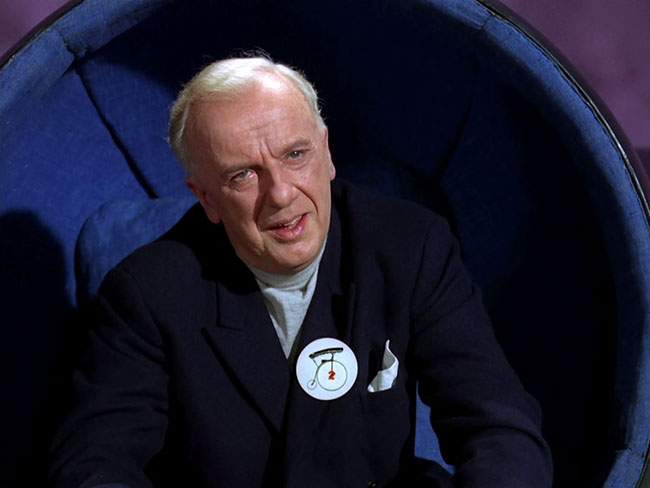
Andre Van Gyseghem as the retiring No.2.
VILLAGERS
We now learn of a group of “jammers” in the Village who like to throw off their observers by hatching plots which they have no intention of pursuing. This group will not be mentioned again. I do like the portrait of Villagers in this episode, which is diverse and interesting: the disgruntled old Watchmaker, his sympathetic daughter No.50, the amusing portrait artist, and the efficient observer No.8 who collects her file on No.6 in a pretty nifty-looking computer room. Although “It’s Your Funeral” has its share of inconsistencies with other Prisoner episodes, this feels like a very lived-in, believable Village.
FISTICUFFS
No.6 fights with No.100 for control of the trigger mechanism.
METHODOLOGY
Here No.6 is just a pawn in the new No.2’s game. He only wishes to use and then discredit No.6, hoping his warnings of an assassination plot fall on deaf ears. No attempt to learn why he resigned is made, and, like “The General,” this seems to be just another portrait of a “day in the life of the Village.”
WIN OR LOSE?
No.6 wins, foiling the assassination plot at the last possible moment and allowing the retiring No.2 to escape with his life. Although it would be possible to turn the helicopter around (as I noted for the similar ending of “Do Not Forsake Me Oh My Darling”), it wouldn’t be wise to do so, because it could result in the death of the new No.2.
QUOTES
No.6: Many times bitten, forever shy. But they are not shy. They love to listen.
Watchmaker: You don’t understand. What I am doing is for a principle. We are in this prison for life, all of us. But I have met no one here who has committed a crime. I will protest in a manner they cannot ignore.
No.6: There are some unhappy people here.
No.2: Yes, well I have seen the list of malcontents. It might interest you to know that you happen to be top of the bill.
No.6: I’ll do my best to live up to it.No.6 (to the New No.2): And so the great day is nearly over. Come off rather well, I thought. Better than planned. And now you can even look forward to your own retirement, and I’m sure they’ll arrange something equally suitable for you when the day comes. Be seeing you – won’t I?
UP NEXT: LIVING IN HARMONY
